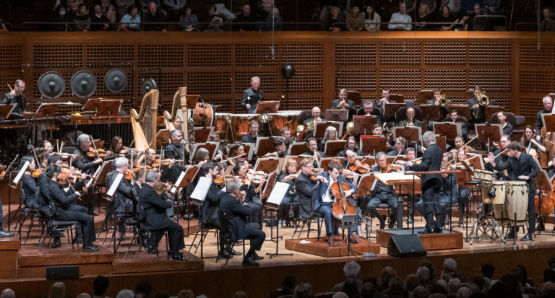 United States Beethoven, Salonen, Debussy: Rainer Eudeikis (cello), San Francisco Symphony / Esa-Pekka Salonen (conductor). Davies Symphony Hall, San Francisco, 18.10.2024. (HS)
United States Beethoven, Salonen, Debussy: Rainer Eudeikis (cello), San Francisco Symphony / Esa-Pekka Salonen (conductor). Davies Symphony Hall, San Francisco, 18.10.2024. (HS)

Beethoven – Symphony No.6, ‘Pastoral’
Salonen – Cello Concerto
Debussy – La Mer
In his final season as the San Francisco Symphony’s music director, Esa-Pekka Salonen has assembled some of his most intriguing programs. To frame his 2016 cello concerto, this program opened with Beethoven’s ‘Pastoral’ Symphony and closed with Debussy’s La Mer, two familiar pieces that, like the concerto, look to nature for inspiration.
Written for Yo-Yo Ma and programmed here to showcase Rainer Eudeikis, who joined the orchestra in 2022 as principal cellist, the concerto departs from traditional musical structures. So did Beethoven in the ‘Pastoral’, which played against the four-movement symphony with what are basically five tone poems. In La Mer, Debussy used the tone poem format, primarily designed to follow a narrative, to make the whole piece about atmosphere, specifically the ocean.
Friday in Davies Symphony Hall was the first San Francisco Symphony performance of Salonen’s concerto, and the first opportunity for local audiences to experience Eudeikis as a concerto soloist. He did not disappoint, executing the extraordinarily fiendish technical demands with aplomb and finding the lyrical heart of the music. Where classical concertos usually place the soloist in opposition to the orchestra, Salonen positions the soloist as simply the busiest of the musicians at play, using the orchestra to extend the cello’s lines in ingenious ways. Various live instruments trail the cello in segments that are almost, but not quite, canons.
The second movement makes use of an electronic surround-sound looping system to create an echo of a melodic cello phrase, to which the cello then harmonizes or adds an extra counterpoint to itself. Most arresting was a long, slow, flowing contrapuntal duet with alto flutist Katrina Walter interweaving melodic overlaps.
These moments created a sense of being in nature, and they worked better than Salonen’s idea of opening the concerto with dense dissonance in the orchestra. That fits the idea of nature, in which simplicity can emerge from chaos as the single line of the cello surfaces and the rest dies away, but it is also the only time we hear such loud dissonance. The rest of the movement settles into episodes swinging from playful to ethereal.
Slow, rich harmonies created a resonant episode in the second movement, with a rack of tuned gongs adding exotic color to underline each of the orchestra’s harmonies, and the cello laid a blanket of lacy melodic lines over that. In the third and final movement, principal percussionist Jacob Nissly joined the cellist downstage, flanking the conductor, to add the rhythms of bongo drums and conga drums in two sizes. They not only brought in some smile-inducing dance rhythms, but their tuned sound created an exotic tapestry against the cello’s increasingly virtuosic music.
At the end, the cello breaks free from it all and soars into the stratosphere of its range, finishing on a high note that, one last time, gets whipped into an electronic loop whirlwind to dissipate at the very end.

Through all this, Eudeikis fulfilled the classical idea of a virtuoso, not by competing against the orchestra but by outdoing everyone with musical gymnastics. The cello hardly rested, the complexity of its music increasing as the piece evolved. It was quite a ride, even if Eudeikis had to take a time-out of several minutes to replace a string that broke just before the finale.
La Mer, which occupied the second half of the concert, surged with energy from the top. Salonen’s preference for precision gave the music a certain clarity. A little more flexibility might have brought out more of the suppleness in the ocean waves that Debussy depicted, but the high-def character created an irresistible momentum to the big splashes of several climaxes.
The ‘Pastoral’, however, was so bright in tone that it missed the warmth in the music. Crisp textures and brisk tempos kept things moving, but the piece needed to breathe so it could reflect the expansiveness of nature that Beethoven depicted. The best movement, of course, was the fourth movement ‘Thunderstorm’, which benefited from Edward Stephan’s timely (and rhythmic) timpani interjections.
Harvey Steiman
